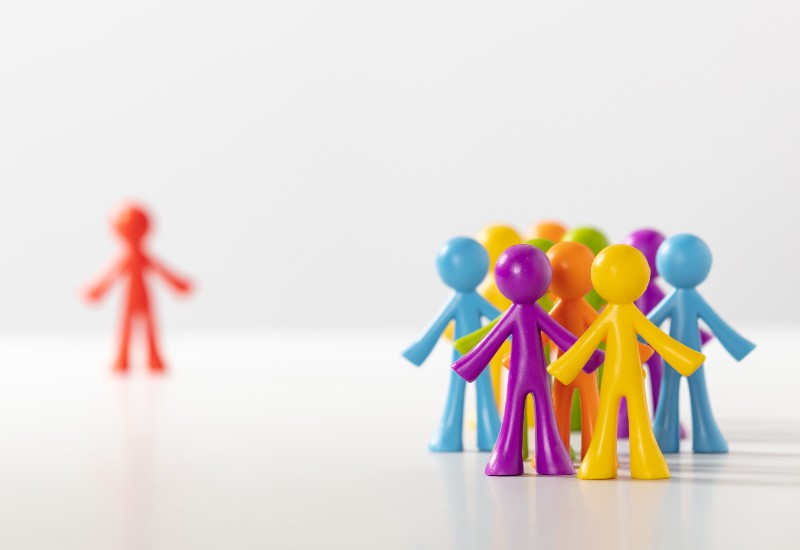Welcome to part 2 of our blog series on Exploring Aggressive Behavior and Bullying in Children. In our previous installment, we explored the cycle of bullying. Here, we’ll shift our focus to a lesser-known yet equally significant aspect of bullying: “Reverse Bullying” and its impact on children.
While bullying often brings to mind images of physical aggression or verbal taunts, “reverse bullying” takes a different form—one that is equally damaging but less conspicuous. This insidious behavior manifests as exclusion, where certain children purposefully exclude others from social interactions and activities, leaving lasting emotional scars.
By examining the emotional and psychological consequences and the long-term effects of exclusion, we want to emphasize the urgency of recognizing and addressing this form of aggression. Furthermore, we will discuss how to identify the signs of reverse bullying, explore strategies to create inclusive environments and provide support to both the child who excludes and the child who is targeted.
What is Reverse Bullying?
While bullying is a pervasive issue that affects countless children worldwide, it’s not limited to overt acts of aggression. Reverse bullying, also known as exclusion, is a subtle yet equally damaging form of bullying that often goes unnoticed or disregarded.
Reverse bullying involves a deliberate act of excluding or isolating a particular individual or group from social interactions, activities, and friendships. It involves the intentional rejection and marginalization of others, leading to feelings of isolation, sadness, and self-doubt.
Exclusion can manifest in various ways, each with its own nuances and impact. It may involve purposefully leaving someone out of social gatherings, parties, or group activities. It can also occur through the creation of cliques or exclusive circles where certain individuals are intentionally excluded. Additionally, exclusion can take place in digital spaces through cyberbullying and social media ostracism.
Several factors contribute to the occurrence of reverse bullying. These may include
- the desire for social dominance
- peer pressure
- envy
- insecurity
- a lack of empathy
Additionally, societal influences, cultural norms, and media portrayal of popularity and exclusivity can also play a role in perpetuating this behavior among children.
What Does Exclusion Look Like?
Reverse bullying can occur in different contexts, such as school, extracurricular activities, or even within family and friendship circles. Examples of this behavior may include
- intentionally ignoring or refusing to acknowledge someone’s presence
- spreading rumors to isolate an individual
- using exclusionary tactics to exert power and control over others.
The Impact of Exclusion on Children
Exclusion can have profound and long-lasting effects on the well-being and development of children. The experience of being deliberately left out or marginalized can inflict significant harm, both emotionally and academically. Understanding the impact of exclusion is crucial for recognizing the urgency of addressing this issue and providing necessary support to children affected by it.
Emotional and Psychological Effects:
- Low self-esteem and self-worth: Exclusion sends a message to children that they are not valued or accepted, leading to a diminished sense of self-worth. It can erode their confidence, self-esteem, and belief in their own abilities.
- Increased feelings of loneliness and isolation: Being excluded from social interactions and friendships can intensify feelings of loneliness and isolation. Children may experience a sense of being disconnected from their peers and may struggle with forming meaningful relationships.
- Development of anxiety and depression: The emotional toll of exclusion can contribute to the development of anxiety and depression in children. Persistent feelings of sadness, fear of rejection, and a constant sense of being on the outskirts of social groups can take a toll on their mental well-being.
Academic Consequences:
- Decline in academic performance: Exclusion can significantly impact a child’s ability to concentrate, engage in learning, and perform academically. The emotional distress caused by being excluded can distract them from focusing on their studies and hinder their overall academic progress.
- Difficulty concentrating and learning: Children who are excluded may struggle to concentrate in the classroom due to preoccupation with their social standing and the negative emotions associated with exclusion. This can impede their ability to fully participate in learning activities and absorb educational content.
Long-term Implications
Experiencing exclusion during childhood can have long-term consequences on a child’s social skills and ability to form trusting relationships. They may develop a guarded approach to social interactions, leading to difficulties in building friendships and maintaining healthy connections.
Children who engage in reverse bullying may perpetuate exclusionary behaviors into adolescence and adulthood. This can create a cycle of bullying and perpetuate a culture of exclusion, impacting future generations.
Recognizing the detrimental effects of exclusion is crucial. By understanding the emotional and academic consequences, we can prioritize creating inclusive environments, promoting empathy, and implementing effective interventions to address reverse bullying. Let’s explore strategies to recognize the signs of reverse bullying, fostering a supportive and inclusive atmosphere for all children.
Recognizing Signs of Exclusion
While exclusionary behavior may not always be overt or easily noticeable, there are indicators that can help us recognize when a child is engaging in or experiencing reverse bullying. By being attentive and observant, we can take proactive steps to address this harmful behavior. Here are some signs to look out for:
Behavioral Changes in Children Who Exclude
Children who engage in reverse bullying often form tight-knit groups that intentionally exclude others. They may actively discourage or reject attempts by others to join their group. Exclusionary children may consistently ignore or purposely leave out certain individuals from social activities, conversations, or group projects. Those involved in reverse bullying may engage in spreading rumors, gossip, or negative comments about the targeted individuals to isolate them further.
Emotional and Behavioral Indicators in Targeted Children
Children who are excluded may exhibit signs of sadness, withdrawal, or reluctance to participate in social activities. They may become more reserved or reluctant to engage with others. Experiencing exclusion can erode a child’s self-esteem and confidence. They may display self-doubt and uncertainty, or express feelings of worthlessness. Targeted children may actively avoid social situations, preferring to isolate themselves to avoid the pain of rejection. They may exhibit changes in their social behavior, such as avoiding eye contact, staying alone during recess, or distancing themselves from peers.
Strategies for Parents and Educators
- Open dialogue: Encourage open communication with children, creating a safe space where they feel comfortable sharing their experiences. Regularly check in with them about their social interactions, friendships, and any concerns they may have.
- Observation and documentation: Observe children’s interactions and behaviors in various social settings, both at school and in other activities. Document any recurring patterns of exclusion or signs of distress.
- Collaboration with educators and professionals: Maintain open lines of communication with teachers, school counselors, and other professionals involved in the child’s life. Share observations and concerns, seeking their insights and support.
By actively recognizing the signs of reverse bullying, we can intervene early and provide the necessary support to both the children who exclude and those who are targeted. Collectively supporting the child who excludes and the targeted child, can help us work towards transforming their behaviors, fostering empathy, and creating a culture of inclusivity. Together, let us strive for a future where all children feel valued, accepted, and supported in their social environments.
the road to wellness starts by seeking help. today.
Built on the principles of assertive community treatment, Galen Hope is an eating disorder and mental health treatment center offering individualized treatment options that include Intensive Outpatient (IOP), supported housing, and Partial Hospitalization Programs (PHP). As a “Community of Integrated Wellness,” we pride ourselves in fostering a thoughtful and meaningful care experience that can guide our clients on their road to recovery and increased quality of life, regardless of diagnosis. Galen Hope currently offers separate, age-specific programming for adolescents ages 12-17 and adults 18 and up, of all genders.
To learn more, or to join our community for integrated wellness, please contact us today.
Belong. Heal. Grow.

